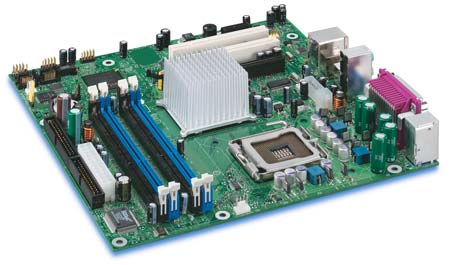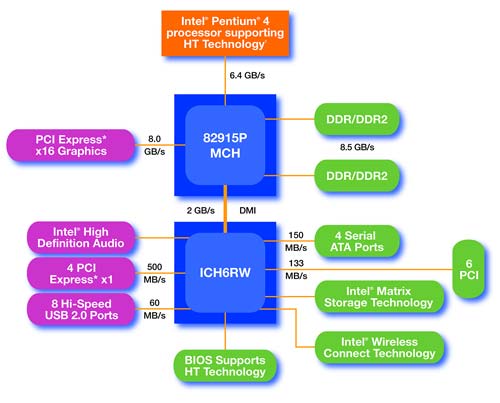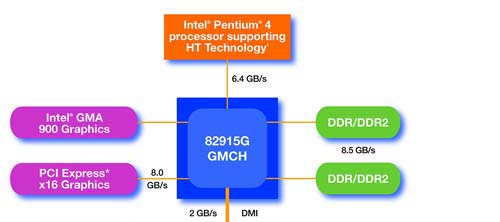Intel 925X/915: Chipset Performance & DDR2
by Wesley Fink on June 19, 2004 3:01 AM EST- Posted in
- CPUs
Intel 915G Express
Intel also provided a D915GUX motherboard for evaluation.
The 915 chipset comes in several flavors, both with and without the new Intel integrated graphics.

Most mainstream boards geared to AnandTech readers will feature the 915p chipset, without integrated graphics. The chipset is essentially a 925X without the acceleration technology, but with the added option of using either DDR or DDR2 memory, depending on what memory support the manufacturer chooses to provide. Other options are provided by the Southbridge and depend on which ICH6 version is paired with the 915P.

915G offers the same options as 915P, but adds Intel's integrated graphics. Intel has significantly upgraded integrated graphics for the 915 chipset, and now support DirectX 9 and OpenGL 1.4 on their integrated graphics. The new solution is called "Intel Graphics Media Accelerator 900". Intel claims that performance is doubled over Intel Intense Graphics 2. AnandTech takes a closer look at the performance of the new Intel integrated Graphics in the review of the Socket 775 CPU launch and PCIe Graphics that is the companion to this article. There is also an economy version of the 915 called 915GV, with integrated Media Accelerator 900 graphics, but without a PCIe 16X graphics card slot. We suspect that the 915GV will become a favorite of the Corporate desktop.

The D915GUX that we evaluated had all of the 915 features in a micro ATX form factor. Despite the smaller size, the D915GUX still provides integrated graphics, plus a PCIe 16X graphics slot, a PCIe 1X slot, and 2 PCI slots. All of the Intel boards, even the 915gux, provide 4 DIMM slots and support up to 4GB of memory. Please also notice that a 24-pin power connector, and not a 20-pin, is also a feature of 915 boards. 20-pin is backwards compatible, however, and the 24-pin is keyed to accept a standard 20-pin connector on one side of the new 24-pin.










57 Comments
View All Comments
Cygni - Saturday, June 19, 2004 - link
The three big "must upgrades", DDR2, BTX, and PCIe will offer little to no reason for people to switch over. This is one of those rare times where I say go ahead and spend. There really isnt anything much better on the immediate horizon. Get a nice high end P4 or A64 setup with the nicest vid card you can find and enjoy. All the new tech is useless.On the 925/915 itself, the high quality audio, upped integrated graphics, and 4 SATA ports are all good things for sure. Im waiting to see how the audio and graphics perform. Could be a future super-platform for low end computers.
JustAnAverageGuy - Saturday, June 19, 2004 - link
#4You're probably right.
Would have been a much fairer comparison had they used the same CPU.
A Northwood on 875
vs a
Prescott on 925
hardly compares the chipsets.
A prescott on 875
vs a
Prescott on 925
probably would have been a bit more objective.
JustAnAverageGuy - Saturday, June 19, 2004 - link
Is that a typo on page 19?Second graph
http://www.anandtech.com/chipsets/showdoc.html?i=2...
rjm55 - Saturday, June 19, 2004 - link
I'm sure Intel won't like this review, but it exactly the reason I keep coming back to Anandtech to see what's really going on in computers. Thanks for asking the hard questions, and reporting the answers honestly!You just saved me a lot of disappointment on my next upgrade - which will now be an Athlon 64.
thatsright - Saturday, June 19, 2004 - link
#8, GhandiInstinctDude!!! You need to get out a bit more man!
overclockingoodness - Saturday, June 19, 2004 - link
Not to mention the fact that with practically no performance differences, Intel is trying to change the whole hardware industry. It is very hard to keep up with technologies these days, but it's annoying when the performance gains are minimal.overclockingoodness - Saturday, June 19, 2004 - link
So let's see what we have here...1. AMD is better in performance wise than Intel's new chipsets and LGA775 processor, however, the difference is not that big.
2. There isn't a much difference between PCIe and AGP graphics cards (even though it is not tested yet), but one would suspect the performance difference to be rather minimal.
3. 875P chipset is better than Grantsdale and Alderwood chipsets.
4. DDR "I" is better than DDR II.
Basically, all the new technologies have failed as far as the performance results are concerned. People should now go with AMD64 systems. If you still want to stay with Intel, it is better to predict that a good high-end 875P system will still be better for another 6 months, if not more. Secondly, people shouldn't jump on the new hardware as soon as it comes out. Wait for the new technologies to mature. And if you really want to jump bandwagon of new technologies, purchase a board that supports both DDR2 and DDR memory modules, choose DDR modules and save some money as DDR 2 modules are heavily priced. However, you will have to jump the PCIe graphics bandwagon, but I guess you win some and lose some.
Is it me or is Intel not holding up that well this year? Maybe this is a bad year for them. Research reports show that Intel will remain at the top but AMD will gain more market shares this year, which is expected.
Did I missed something or am I pretty much on the right ball?
overclockingoodness - Saturday, June 19, 2004 - link
medfly - Saturday, June 19, 2004 - link
the thing that i was most dissapointed in, is the fact that intel feels they need to shaft non sata users by only providing one pata channel. Intel's anti consumer attitude "you'll upgrade when we tell you to" with constantly changing sockets, crippled chipsets (remember how 815 only supported 512 megs ram when the older 440bx did 2 gigs of ram in an attempt to force people to the extremely expensive (and slow) P4 platform at the time), will only force more and more of the white box and DIY market to amd.GhandiInstinct - Saturday, June 19, 2004 - link
This article has let me down completely. I have been looking forward to this new technology for my new system build. To see the benchmarks and the virtual lack of performance gains has hit me like a bullet.A novice computer builder hears "3.6ghz, PCI-E, DDR2, ICH6" and goes insane with happiness.
I beg the question, has Intel lost its mojo? Trying to redfine the computer world by exhibiting hardware that barely exceeds the preceeding hardware? What is a man to do?
I should admit, I am a hyper-threading fanatic. But Since A64 beat Intel in everything, I guess "hyper-transport" is what I'll settle with.
The message is clear, my life is over....